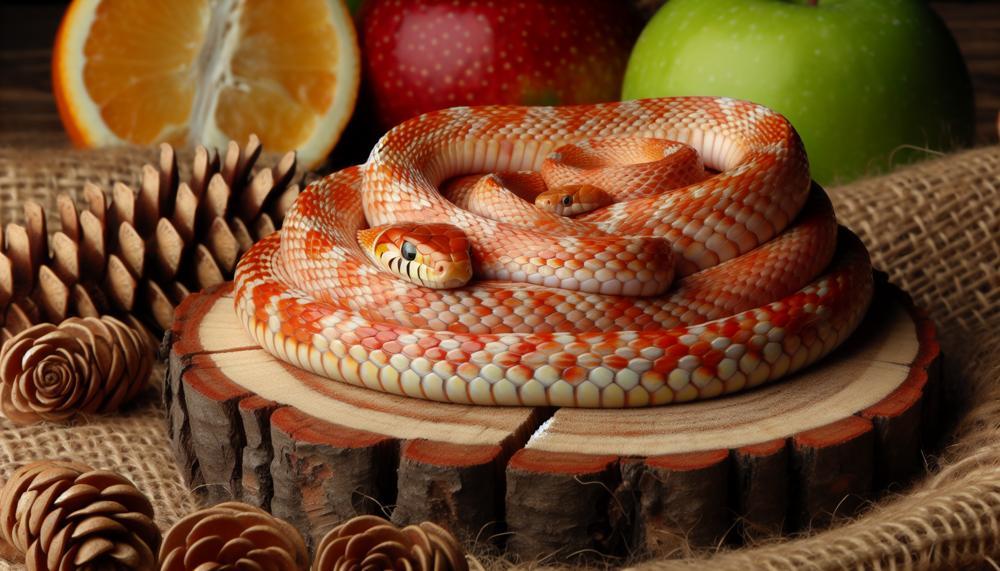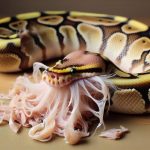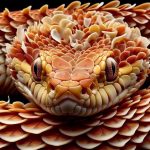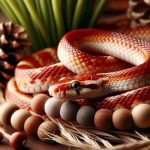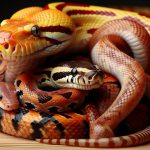Corn snakes, with their striking colors and gentle demeanor, are a popular choice for pet owners.
But did you know that these fascinating creatures have a unique hibernation process?
Yes, corn snakes hibernate in the fall and winter. In the wild, they usually hibernate from October to April, but snakes in the south may stay active later and emerge earlier in the spring. Reptiles, including snakes, go through a brumation cycle over the winter. Brumation is different from hibernation, which is a process that warm-blooded animals go through.
Whether you’re a proud owner of a corn snake or simply curious about these slithery creatures, read on as we uncover the secrets of their hibernation process.
Contents
- 1 Where do Snakes Hibernate? (The Hibernacula)
- 2 Do Snakes Hibernate in Houses?
- 3 Why do Snakes Hibernate?
- 4 When do Snakes Hibernate?
- 5 Do Snakes Hibernate in Groups?
- 6 Which Species of Snakes are Known to Hibernate?
- 7 What is Snake Brumation?
- 8 How do Brumating Snakes React to Weather Changes?
- 9 Conclusion
Where do Snakes Hibernate? (The Hibernacula)
Corn snakes have a variety of options for hibernation, whether in the wild or in captivity. In their natural environment, they will seek out cozy underground burrows, hollow logs, or rock crevices to brumate during the colder months. In captivity, they may opt for a dark and warm area in their terrarium or even bury themselves in the bedding material.
To gain a better understanding of where corn snakes hibernate during the winter months, we can break it down into different scenarios:
- In the wild: Corn snakes are native to North America, with a range that spans from New Jersey to Florida and as far west as Texas and Oklahoma. In colder regions, they typically brumate from October to March. During this time, they can be found in secure underground burrows or other sheltered locations that provide warmth and protection from harsh weather conditions.
- In Florida: While Florida corn snakes experience milder winters compared to their northern counterparts, they still undergo a period of brumation during the colder months. However, due to the relatively mild temperatures, they may not necessarily seek out underground burrows or other sheltered locations. Instead, they may remain active but reduce their activity levels and feeding schedule.
- In captivity: As mentioned earlier, corn snakes can brumate at any time of the year if necessary. In captivity, owners may choose to simulate a winter slowdown for their corn snakes by creating a cooler environment with less daylight hours and reducing their feeding schedule. During this time, corn snakes can be found hibernating in hiding spots within their terrariums.
To sum it up, corn snakes can be found hibernating in various locations depending on their natural habitat or environmental conditions in captivity. Whether it is underground burrows or hiding spots within their terrariums, these places provide warmth and protection for the snake during the period of brumation.
Overall, it is important for owners to understand where their pet corn snakes hibernate and how to properly care for them during this period.
Do Snakes Hibernate in Houses?
When winter comes, corn snakes get ready for hibernation in their homes by reducing their food intake and gradually lowering the temperature in their enclosure. Owners should also provide hiding spots and consider using a thermostat to maintain a safe temperature.
This process is crucial for the snake’s well-being during hibernation. The following table summarizes the steps to prepare a corn snake for hibernation in a home environment.
| Step 1: Reduce Food Intake | Step 2: Gradually Lower Temperature | Step 3: Provide Hiding Spots | Step 4: Consider Using a Thermostat |
| In the wild, corn snakes naturally eat less as the days get shorter and the temperature drops. | In a home environment, owners can mimic this natural decrease in food intake by gradually reducing the amount of food offered to the snake. | Hiding spots are essential for creating a natural environment for the snake and allowing them to feel safe and secure during hibernation. | A thermostat can help regulate temperature levels in the enclosure, ensuring it does not drop below 50°F (10°C), which can be dangerous for the snake’s health. |
Why do Snakes Hibernate?
It allows them to conserve energy and endure harsh environmental conditions, while also regulating their reproductive cycle and maintaining their overall health. This natural process has many benefits, including preventing excessive weight gain, balancing hormone levels, and boosting the immune system. Simply put, hibernation is a vital aspect of a corn snake’s life.
But why do snakes hibernate in the first place?
For starters, it helps them survive through the winter season when food becomes scarce and temperatures drop significantly. By slowing down their metabolism and conserving energy, they can endure long periods of time without eating. This is especially important for wild snakes that may not have access to food during the colder months.
Furthermore, hibernation also plays a crucial role in regulating a snake’s reproductive cycle. Just like humans, snakes have hormones that control their breeding and fertility. Hibernation helps balance these hormones and prepares the snake’s body for breeding season when warmer weather arrives.
In addition, hibernation also helps maintain a snake’s overall health. By slowing down their bodily functions, it allows their body to rest and rejuvenate. This is essential for keeping their immune system strong and preventing illness.
When do Snakes Hibernate?
Corn snakes do not follow traditional hibernation patterns, but they do experience brumation cycles that can last for several weeks. This typically occurs during the colder months when their activity slows down, and they require less food to survive.
The brumation period for corn snakes usually begins in late fall and ends in early spring, although this can vary depending on the individual snake and its environment.
Various factors can influence the length of a corn snake’s brumation period, including temperature, light exposure, and food availability. For instance, snakes kept in warm and well-lit environments with consistent access to food may not go through brumation at all.
On the other hand, those exposed to colder temperatures and less light may enter a deeper state of brumation and have a longer period of inactivity.
Here is a summary of key information about the brumation period for corn snakes:
| Brumation Period for Corn Snakes | Starts in Late Fall | Lasts until Early Spring |
| Factors That Affect Length | Temperature | Light Exposure |
| Food Availability | ||
| Brumation Patterns in Captivity | May not occur if kept in warm, well-lit environment with consistent access to food | May enter a deeper state of brumation with colder temperatures and less light exposure |
Do Snakes Hibernate in Groups?
During winter, corn snakes in colder regions may go into a form of hibernation called “brumation.” This period is essential for their survival as it allows them to conserve energy and avoid harsh weather conditions.
Depending on their natural habitat, corn snakes may choose to hibernate alone or in groups. This decision is often influenced by the availability of food and the need for added warmth and protection.
In contrast, corn snakes in warmer regions do not experience the same need for brumation. Instead, they remain active throughout the year and do not hibernate. These snakes will typically live solitary lives, without any social interaction with other snakes.
However, during brumation, multiple corn snakes may gather together in a den-like area to share body heat and provide protection from the cold. Despite this temporary gathering, corn snakes are still solitary animals and do not exhibit social behavior with other snakes.
It is crucial to create a suitable environment for your corn snake during brumation if needed. This includes ensuring proper temperature levels and providing a safe hiding place for your pet to rest during this period.
Which Species of Snakes are Known to Hibernate?
Certain species of snakes possess the ability to enter a state of dormancy during the winter months, commonly referred to as hibernation or brumation. This allows them to conserve energy and survive the cold temperatures when food is scarce.
Let’s take a closer look at which species of snakes are known to hibernate and how corn snakes fit into this category.
Communal Hibernators:
Many species of snakes tend to hibernate in groups for warmth and protection. These include blue racers, eyelash vipers, garter snakes, grass snakes, kingsnakes, and common European adders.
Communal hibernation allows these snakes to save heat and share resources, making it easier for them to survive the harsh winter conditions.
Solitary Hibernators:
On the other hand, some species of snakes prefer to hibernate alone, such as corn snakes and hognose snakes. In colder regions, corn snakes may temporarily gather with other snakes for warmth, but they typically hibernate alone.
Hognose snakes spend most of their time underground during winter, conserving energy until spring arrives.
Non-Hibernators:
In warmer regions, some snakes do not hibernate at all and remain active throughout the year. These include pine snakes, which hibernate twice a year, and certain populations of corn snakes.
Although these non-hibernating snakes may experience periods of reduced activity during colder months, they do not enter a state of dormancy like their hibernating counterparts.
What is Snake Brumation?
Snake brumation is a natural process that occurs during the winter months for snakes. During this time, snakes enter a low-energy state to conserve energy and survive harsh conditions.
It is often compared to hibernation, but there are significant differences between the two.
The Differences Between Snake Brumation and Hibernation:
| Snake Brumation | Hibernation |
| Occurs during the winter months | Occurs during colder months, typically winter |
| Brumation can be triggered by factors such as temperature and food availability | Hibernation is mainly triggered by cold temperatures |
| Snakes may wake up during brumation to drink, go to the bathroom, or bask in the sun | Hibernating animals remain in a deep sleep until spring |
| Snakes can still sense their surroundings and may move around during brumation | Hibernating animals experience a decrease in heart rate, breathing, and metabolic activity |
| Some snake species, like corn snakes, may opt for communal brumation with others of the same species | Hibernating animals usually prefer to hibernate alone |
| Non-hibernating snakes, such as pine snakes, remain active and do not go into brumation or hibernation. | All mammals hibernate, while only some snake species go into brumation. |
In summary, snake brumation is a natural process that allows snakes to conserve energy and survive through tough conditions. Although it is often compared to hibernation, there are notable differences in terms of triggers, behavior, and duration.
As a pet owner, it is crucial to understand these differences and provide suitable conditions for your snake during brumation.
How do Brumating Snakes React to Weather Changes?
When it comes to weather changes during brumation, corn snakes are well-adapted to respond accordingly. In their natural habitat, they seek out sheltered areas such as burrows or rock crevices to protect themselves from extreme temperatures.
As a pet owner, it is crucial to monitor the temperature and humidity levels in your snake’s enclosure to ensure that it remains stable. Sudden changes in these factors can cause stress to your snake and disrupt their brumation process.
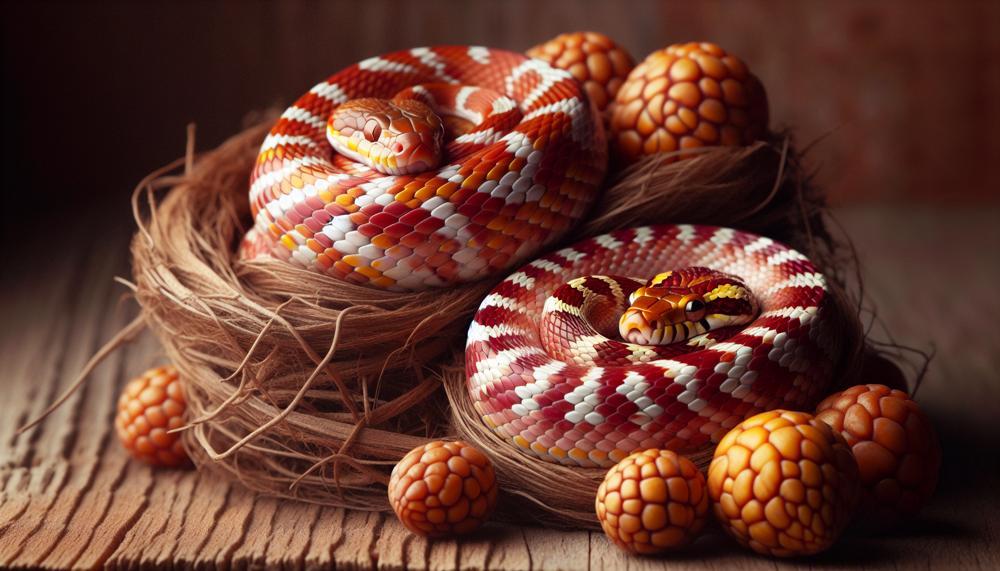
Corn snakes may wake up and move around during brumation, especially if there are significant weather changes. If the temperature drops too low or rises too high, they may become more active and seek a more suitable environment. It is essential for owners to closely monitor their snake during this time and make any necessary adjustments to ensure their well-being.
Besides that, corn snakes may also shed their skin during brumation. While shedding is not a guaranteed occurrence during this period, it is still possible for snakes to shed while in a low-energy state. Pet owners should pay attention to any signs of shedding and provide proper moisture levels to assist the process if needed.
Also Read: Why Is My Ball Python Not Shedding?
Conclusion
In conclusion, corn snakes are more than just beloved pets – they are fascinating creatures with a unique hibernation process. From their natural habitat to captivity, these slithery creatures can be found hibernating in various locations depending on their environment.
It is crucial for owners to understand the significance of temperature regulation and providing hiding spots for their snake’s well-being during this period.
Hibernation serves multiple purposes for corn snakes, including conserving energy, regulating their reproductive cycle, and maintaining overall health. However, unlike traditional hibernation patterns, corn snakes experience brumation cycles that occur during the colder months. The length of this period can vary depending on individual factors and their environment.
Whether they hibernate alone or in groups, it is essential to create conditions that mimic their natural habitat to promote healthy brumation patterns.

